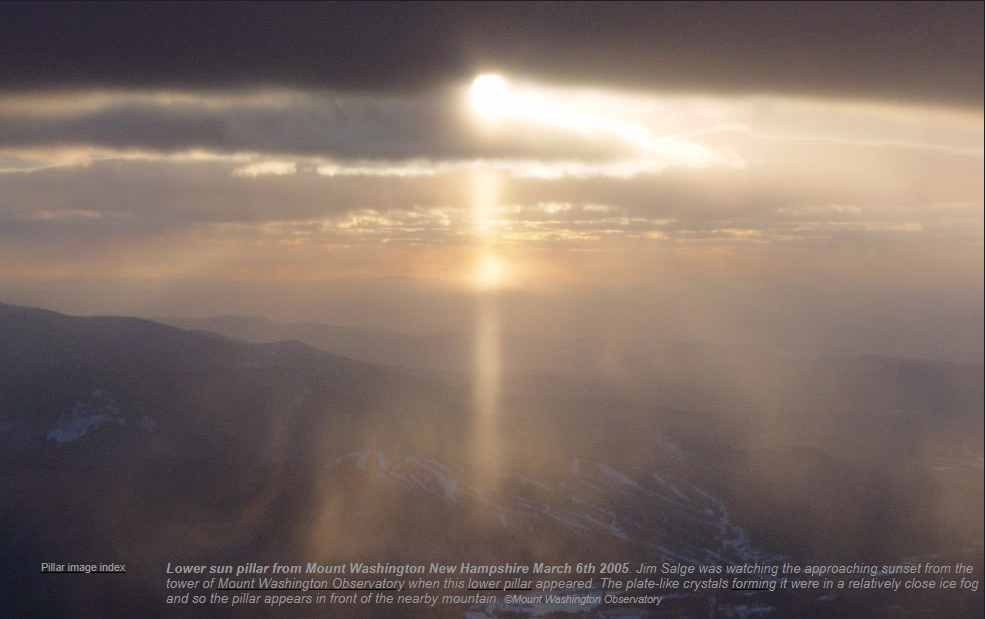Lower Pillar - Mount Washington Observatory
Lower Pillar - Mount Washington Observatory
At the Mount Washington Observatory in New Hampshire, a mesmerizing atmospheric phenomenon known as the lower sun pillar occasionally graces the sky. On March 6th, 2005, Jim Salge, an observer at the observatory, was fortunate enough to witness this captivating sight as the sun began its descent. The lower pillar, formed by plate-like ice crystals suspended in a nearby ice fog, appeared in front of the majestic mountains, creating a surreal spectacle.
The lower sun pillar is a type of optical phenomenon that occurs when sunlight interacts with ice crystals in the atmosphere. It manifests as a vertical column of light extending below the sun, resembling a radiant pillar reaching towards the Earth's surface. Unlike its more common counterpart, the upper sun pillar, which appears above the sun, the lower sun pillar is rarer and often elicits awe and wonder from those fortunate enough to witness it.
To understand how the lower sun pillar forms, we must delve into the intricate interplay between light and ice crystals. The process begins when sunlight encounters hexagonal plate-like ice crystals suspended in the air. These crystals act as miniature prisms, refracting and reflecting light in various directions. When the crystals are oriented horizontally, they can create a lower sun pillar by reflecting sunlight downwards.
The lower sun pillar is often observed in regions where ice fog or mist exists close to the observer. In these conditions, the ice crystals responsible for forming the pillar are relatively nearby, enhancing the visual impact of the phenomenon. The presence of mountains or other prominent objects in the vicinity further adds to the spectacle, as the pillar appears to hover in front of these imposing natural features.
As with many atmospheric optics phenomena, the lower sun pillar's appearance can be influenced by several factors. The size and shape of the ice crystals play a crucial role in determining the characteristics of the pillar. Larger, plate-like crystals are more likely to produce a distinct and well-defined pillar, while smaller crystals may result in a less pronounced effect. The presence of an ice fog or mist, along with the angle of the sun, also contribute to the visibility and intensity of the phenomenon.
Capturing the lower sun pillar in all its glory requires both luck and patience. Observers must be in the right place at the right time, with favorable atmospheric conditions and a clear view of the horizon. The Mount Washington Observatory, situated at an elevation of 6,288 feet (1,917 meters), offers an advantageous vantage point for witnessing this breathtaking spectacle. Its lofty position above the surrounding landscape provides unobstructed views, while its location in a region prone to ice fog increases the likelihood of encountering the lower sun pillar.
The lower sun pillar serves as a reminder of the immense beauty and complexity of our atmosphere. It is a testament to the fascinating interactions between light and ice crystals, resulting in ethereal displays that captivate our imagination. Whether observed from the heights of Mount Washington or other locations fortunate enough to witness this phenomenon, the lower sun pillar is a remarkable sight that reminds us of the wonders that surround us in the natural world.

Lower sun pillar from Mount Washington New Hampshire March 6th 2005. Jim Salge was watching the approaching sunset from the tower of Mount Washington Observatory when this lower pillar appeared. The plate-like crystals forming it were in a relatively close ice fog and so the pillar appears in front of the nearby mountain. ©Mount Washington Observatory
Note: this article has been automatically converted from the old site and may not appear as intended. You can find the original article here.
Reference Atmospheric Optics
If you use any of the definitions, information, or data presented on Atmospheric Optics, please copy the link or reference below to properly credit us as the reference source. Thank you!
-
<a href="https://atoptics.co.uk/blog/lower-pillar-mount-washington-observatory/">Lower Pillar - Mount Washington Observatory</a>
-
"Lower Pillar - Mount Washington Observatory". Atmospheric Optics. Accessed on November 26, 2024. https://atoptics.co.uk/blog/lower-pillar-mount-washington-observatory/.
-
"Lower Pillar - Mount Washington Observatory". Atmospheric Optics, https://atoptics.co.uk/blog/lower-pillar-mount-washington-observatory/. Accessed 26 November, 2024
-
Lower Pillar - Mount Washington Observatory. Atmospheric Optics. Retrieved from https://atoptics.co.uk/blog/lower-pillar-mount-washington-observatory/.